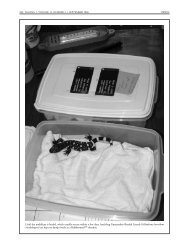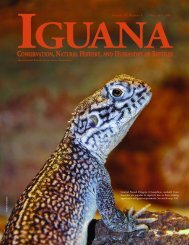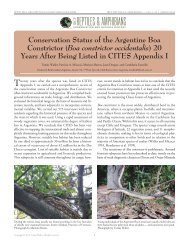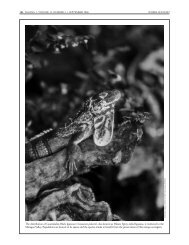Spiny-tailed Iguanas (Ctenosaura similis) in Venezuela
Spiny-tailed Iguanas (Ctenosaura similis) in Venezuela
Spiny-tailed Iguanas (Ctenosaura similis) in Venezuela
Create successful ePaper yourself
Turn your PDF publications into a flip-book with our unique Google optimized e-Paper software.
GUATEMALAN BLACK IGUANA<br />
Ecology and Traditional Use of the<br />
Guatemalan Black Iguana<br />
(<strong>Ctenosaura</strong> palearis) <strong>in</strong> the Dry Forests<br />
of the Motagua Valley, Guatemala<br />
The Semiarid Region of the Motagua Valley (SRMV) is one<br />
of the few regions of Mesoamerica <strong>in</strong> which the unique<br />
tropical dry forest and thorn scrub ecosystem still rema<strong>in</strong>s. One<br />
of the pr<strong>in</strong>cipal characteristics of this region is the presence of<br />
many endemic species (Nájera 2006), such as the Guatemalan<br />
Black Iguana (<strong>Ctenosaura</strong> palearis). The genus <strong>Ctenosaura</strong> is represented<br />
by five species <strong>in</strong> Guatemala: C. alfredschmidti (northern<br />
Guatemala), C. flavidorsalis (eastern Guatemala), C. <strong>similis</strong><br />
Paola Cotí 1 and Daniel Ariano-Sánchez 2<br />
1 Biology Department, Universidad del Valle de Guatemala (paoniz@gmail.com)<br />
2 Research and Conservation Projects Direction, Zootropic Organization (dariano@zootropic.com; darianosanchez@gmail.com)<br />
Hatchl<strong>in</strong>g <strong>Ctenosaura</strong> palearis observed <strong>in</strong> June 2007.<br />
Photographs by the authors.<br />
<br />
IGUANA • VOLUME 15, NUMBER 3 • SEPTEMBER 2008 143<br />
(general distribution), C. acanthura (Nentón Valley), and C.<br />
palearis (Köhler 2003, Acevedo 2006).<br />
<strong>Ctenosaura</strong> palearis was described by Stejneger <strong>in</strong> 1899.<br />
S<strong>in</strong>ce then, few studies have addressed the species. Buckley and<br />
Axtell (1997) studied populations of C. palearis <strong>in</strong> Guatemala<br />
and Honduras, and described the Honduran population as<br />
<strong>Ctenosaura</strong> melanosterna. <strong>Ctenosaura</strong> palearis is believed to have<br />
a total distribution range of less than 100 km 2 . Total population<br />
size is unknown, but may consist of fewer than 2,500 mature<br />
<strong>in</strong>dividuals <strong>in</strong> the wild (Köhler 2004). The males of this species<br />
have been reported to atta<strong>in</strong> a total length of 56.5 cm, and the<br />
females 48.5 cm (Köhler 2003).<br />
<strong>Ctenosaura</strong> palearis is <strong>in</strong>cluded <strong>in</strong> the IUCN Red List as<br />
Critically Endangered (CR), but the lack of ecological <strong>in</strong>formation<br />
makes develop<strong>in</strong>g conservation strategies difficult. To facilitate<br />
that process, we here<strong>in</strong> describe some ecological aspects and<br />
traditional uses of the Guatemalan Black Iguana <strong>in</strong> the dry forest<br />
of the Motagua Valley.<br />
Material and Methods<br />
The SRMV is located <strong>in</strong> northeastern Guatemala. This region<br />
has the lowest average ra<strong>in</strong>fall <strong>in</strong> Central America (500 mm) and<br />
comprises an area of about 200,000 ha, cover<strong>in</strong>g portions of the<br />
departments of El Progreso, Zacapa, and Chiquimula.<br />
Fieldwork was conducted <strong>in</strong> the mounta<strong>in</strong>s of El Arenal Village,<br />
Cabañas, and Zacapa. Cabañas is located 150 km from<br />
Guatemala City at the geographic coord<strong>in</strong>ates 14º56'32" N and<br />
89º48'24.9" W. The vegetation <strong>in</strong> this area is composed ma<strong>in</strong>ly<br />
of Mimosaceae, Cactaceae, Fabaceae, Euphorbiaceae, and<br />
Burseraceae. Representative species <strong>in</strong>clude Zacapan Oak<br />
(Bucida macrostachya), Quebracho (Licania hypoleuca), Palo de<br />
Jiote (Bursera simaruba), Yaje (Leucaena sp.), Zarza Blanca<br />
(Mimosa platycarpa), Manzanote (Pereskia autumnalis), Cactus<br />
Cabeza de Viejo (Pilosocereus albocephalus), Stenocereus spp.,<br />
Subín (Acacia spadicigera), Opuntia sp., Naranjillo (Jacqu<strong>in</strong>ia<br />
spp.), and Piña de Coche (Hechtia guatemalensis) (Ariano-<br />
Sánchez 2003).








